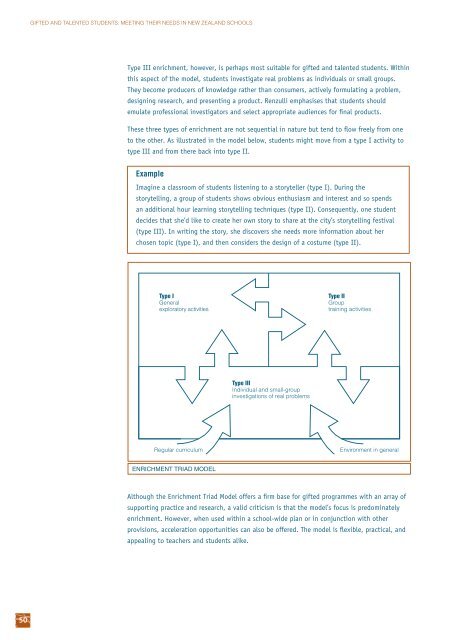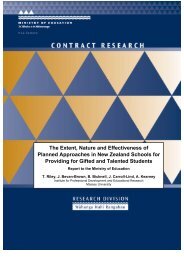Gifted and Talented Students - Meeting Their Needs in New Zealand ...
Gifted and Talented Students - Meeting Their Needs in New Zealand ...
Gifted and Talented Students - Meeting Their Needs in New Zealand ...
Create successful ePaper yourself
Turn your PDF publications into a flip-book with our unique Google optimized e-Paper software.
GIFTED AND TALENTED STUDENTS: MEETING THEIR NEEDS IN NEW ZEALAND SCHOOLSType III enrichment, however, is perhaps most suitable for gifted <strong>and</strong> talented students. With<strong>in</strong>this aspect of the model, students <strong>in</strong>vestigate real problems as <strong>in</strong>dividuals or small groups.They become producers of knowledge rather than consumers, actively formulat<strong>in</strong>g a problem,design<strong>in</strong>g research, <strong>and</strong> present<strong>in</strong>g a product. Renzulli emphasises that students shouldemulate professional <strong>in</strong>vestigators <strong>and</strong> select appropriate audiences for f<strong>in</strong>al products.These three types of enrichment are not sequential <strong>in</strong> nature but tend to flow freely from oneto the other. As illustrated <strong>in</strong> the model below, students might move from a type I activity totype III <strong>and</strong> from there back <strong>in</strong>to type II.ExampleImag<strong>in</strong>e a classroom of students listen<strong>in</strong>g to a storyteller (type I). Dur<strong>in</strong>g thestorytell<strong>in</strong>g, a group of students shows obvious enthusiasm <strong>and</strong> <strong>in</strong>terest <strong>and</strong> so spendsan additional hour learn<strong>in</strong>g storytell<strong>in</strong>g techniques (type II). Consequently, one studentdecides that she’d like to create her own story to share at the city’s storytell<strong>in</strong>g festival(type III). In writ<strong>in</strong>g the story, she discovers she needs more <strong>in</strong>formation about herchosen topic (type I), <strong>and</strong> then considers the design of a costume (type II).Type IGeneralexploratory activitiesType IIGrouptra<strong>in</strong><strong>in</strong>g activitiesType IIIIndividual <strong>and</strong> small-group<strong>in</strong>vestigations of real problemsRegular curriculumEnvironment <strong>in</strong> generalENRICHMENT TRIAD MODELAlthough the Enrichment Triad Model offers a firm base for gifted programmes with an array ofsupport<strong>in</strong>g practice <strong>and</strong> research, a valid criticism is that the model’s focus is predom<strong>in</strong>atelyenrichment. However, when used with<strong>in</strong> a school-wide plan or <strong>in</strong> conjunction with otherprovisions, acceleration opportunities can also be offered. The model is flexible, practical, <strong>and</strong>appeal<strong>in</strong>g to teachers <strong>and</strong> students alike.50
















